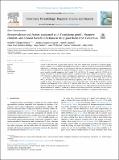| dc.description.abstract | A total of 391 goats from 13 dairy flocks from all Costa Rican regions were analyzed for Toxoplasma gondii-,
Neospora caninum- and Coxiella burnetii-related seroprevalence by enzyme-linked immunosorbent assays (ELISA). Additionally, a risk factor analysis for these parasitic infections was performed based on a questionnaire considering several environmental and housing/management factors. A total of 62.1% (243/391) of individual serum samples revealed seropositive for T. gondii, 7.9% (31/391) for N. caninum, and 1.8% (7/391) for C. burnetii. At herd level, the overall seroprevalence for T. gondii was 100%, for N. caninum 69.2% and for C. burnetii 7.7%. However, no clinical signs related to toxoplasmosis, neosporosis or Q fever were apparent in these flocks. T. gondii-related risk factors were the contact with cats (OR=3.44; CI 95%; 2.0–5.91), dogs (OR=5.75; CI 95%; 2.84–11.66), and white-tailed deer (Odocoileus virginianus) (OR=0.15; CI 95%; 0.08–0.26) within or around the farms. The presence of reproductive males in each flock (OR=0.32; CI 95%; 0.14–0.74) and the coexistence of sheep (OR=0.46; CI 95%; 0.2–1.08) and cattle (OR=5.94; CI 95%; 1.70–20.78) revealed as protective and risk factors respectively for N. caninum infections. This study determined for the first time the seroprevalences of N. caninum, T. gondii and C. burnetii in Costa Rican goat flocks. Particularly, the high withinherd seroprevalences determined for T. gondii requires further surveillance to complement these findings. | es_ES |
| dc.description.abstract | Se analizaron 391 cabras de 13 rebaños lecheros de todas las regiones de Costa Rica para determinar la seroprevalencia relacionada con el Toxoplasma gondii, Neospora caninum y Coxiella burnetii mediante ensayos inmunoenzimáticos (ELISA). Además, se realizó un análisis de los factores de riesgo de estas infecciones parasitarias sobre la base de un cuestionario en el que se consideraron varios factores ambientales y de vivienda/gestión. Un total de 62,1% (243/391) de las muestras de suero individuales revelaron seropositivos para T. gondii, 7,9% (31/391) para N. caninum, y 1,8% (7/391) para C. burnetii. A nivel de manada, la seroprevalencia global para T. gondii fue del 100%, para N. caninum del 69,2% y para C. burnetii del 7,7%. Sin embargo, no se observaron signos clínicos relacionados con la toxoplasmosis, la neosporosis o la fiebre Q en estas manadas. Los factores de riesgo relacionados con T. gondii fueron el contacto con gatos (OR=3,44; IC 95%; 2,0-5,91), perros (OR=5,75; IC 95%; 2,84-11,66) y ciervos de cola blanca (Odocoileus virginianus) (OR=0,15; IC 95%; 0,08-0,26) dentro o alrededor de las granjas. La presencia de machos reproductores en cada rebaño (OR=0,32; IC 95%; 0,14-0,74) y la coexistencia de ovejas (OR=0,46; IC 95%; 0,2-1,08) y bovinos (OR=5,94; IC 95%; 1,70-20,78) se revelaron como factores de protección y de riesgo respectivamente para las infecciones por N. caninum. Este estudio determinó por primera vez las seroprevalencias de N. caninum, T. gondii y C. burnetii en rebaños de cabras de Costa Rica. En particular, las altas seroprevalencias en el interior del rebaño determinadas para T. gondii requieren una mayor vigilancia para complementar estos hallazgos. | es_ES |

